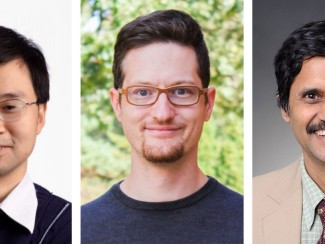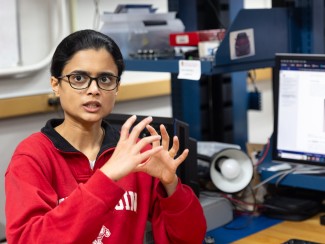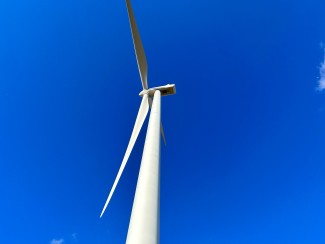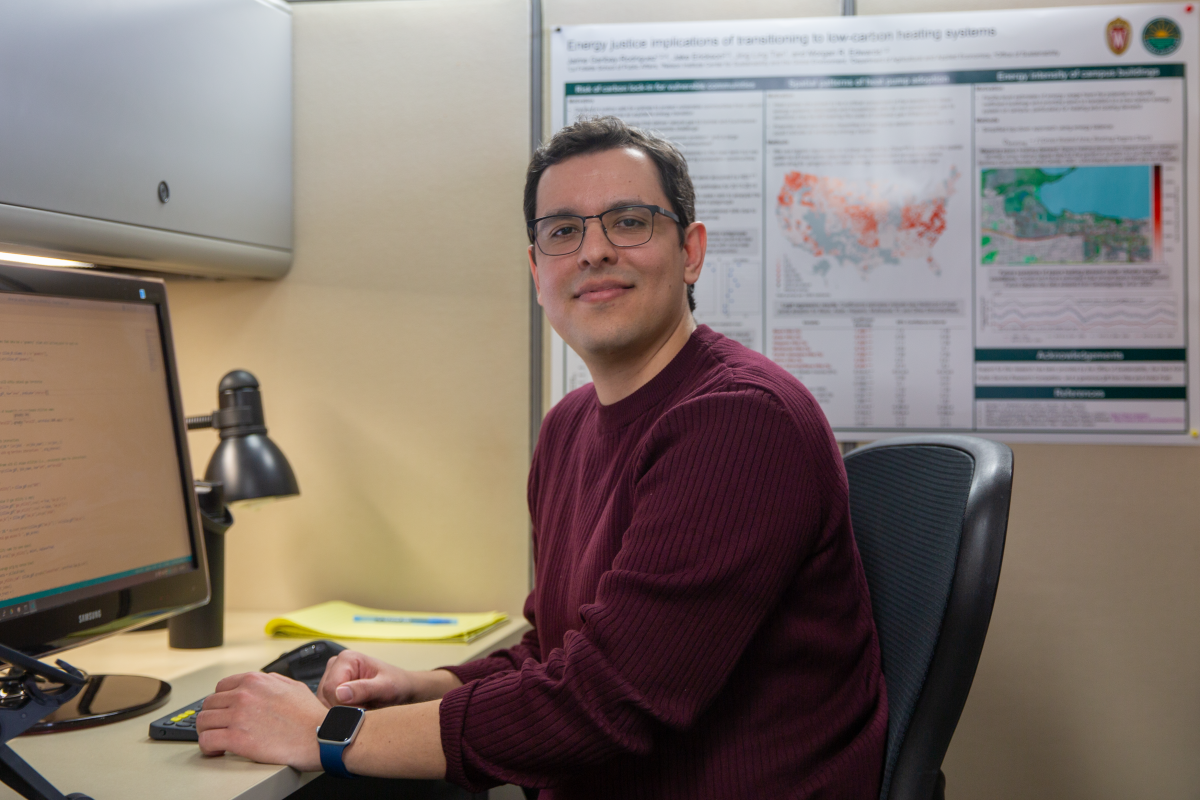
Our graduate students and postdoctoral researchers play an enormous role in the transition to a sustainable, resilient, and affordable energy future that is centered on social and economic equality. From lab experiments to field work to classrooms, these leaders of today and tomorrow are our catalysts for energy discovery.
In this series, we learn more about what inspired these talented researchers, what brought them to their field of study, and the questions that drive their work at the Wisconsin Energy Institute (WEI).
Jaime Garibay Rodriguez is a postdoc in the Morgan Edwards' Climate Action Lab studying sustainable energy transition systems. He got his Ph.D. in Chemical Engineering at Instituto Tecnológico de Celaya, Mexico. He provides insight on the importance of mentors and interdisciplinary collaboration.
Can you describe your research in the Climate Action Lab?
My research is focused on energy justice in the transition to low-carbon energy systems. The current energy system is transitioning out of fossil fuels to mitigate the worst effects of climate change. I research the equity implications around that transition.
In particular, we are analyzing the socioeconomic patterns in the adoption of technologies for building electrification and heat pumps, which are a more energy-efficient way of heating and cooling buildings. We also want to assess something called carbon lock-in associated with building electrification.
What is carbon lock-in?
Some communities could be unfavorably prioritized for fossil fuel infrastructure enhancements, so it can make it difficult for them to transition off fossil fuels towards a cleaner form of energy. If a community largely invested in natural gas pipelines, they want to recover that investment. So when the energy system transitions, those communities may be left behind because all these capital costs will need to be paid. Wealthier communities could transition faster and adopt new and cleaner technologies as they emerge, so they do not experience this carbon lock-in.
What progress have you made in this research?
I’ve only been in the lab for six months, but we are almost finished with our work on socioeconomic patterns of heat pump adoption. That work has been challenging because we are using an extremely large data set to look at U.S. households. The data is actually from the real estate company Zillow. They collect different housing characteristics like square footage, location of the house, heating type, etc. We use that data to decipher the socioeconomic patterns of heat pump adoption.
The national level has its challenges because of the size of the data, but it gives a better picture of what is actually going on. We are seeing that vulnerable communities, in terms of racial minorities and socioeconomic status, are less likely to adopt building electrification technologies such as heat pumps. Heat pumps are thought to be key in the transition to more sustainable forms of energy in the building sector.
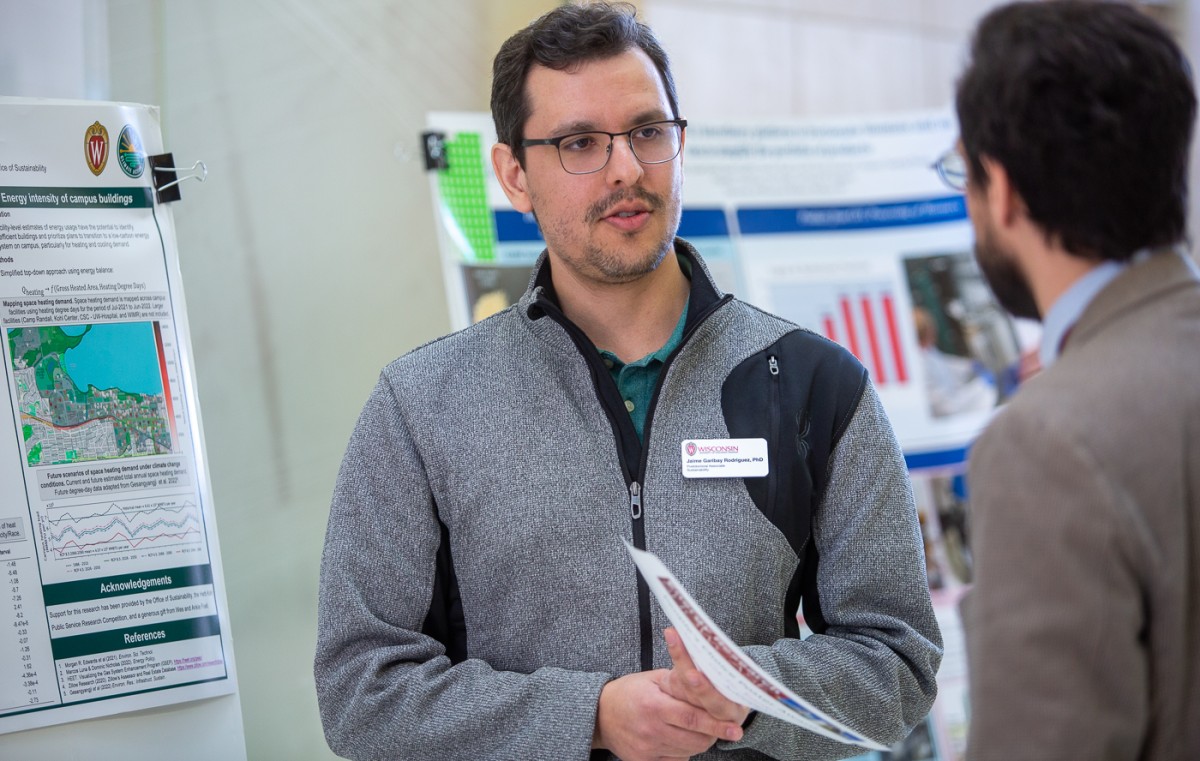
After your Ph.D., you worked at the Helmholtz Center for Environmental Research in Germany, what led to that opportunity and what work did you do there?
I was a research assistant at the Helmholtz Center for Environmental Research for two years. When I came back to Mexico after my time in the Zavala lab in 2019, I finished my Ph.D., and then suddenly the pandemic hit. But, I got the opportunity to go to Germany to continue research in a different research area at a very good institution and research group. It was a great learning experience and helped me fine-tune my technical skills in programming, data management, and software development. I was part of this large-scale European project that was related to energy. I was assessing the impact of nuclear waste disposal. Because the whole continent is very interested in nuclear, I was able to collaborate with many different countries and their agencies.
What made you want to go from a modeling and engineering path to looking at socioeconomic issues like you do in the Morgan Edwards' Climate Action Lab?
Throughout my career, I was very focused on modeling and numerical issues, but I was always interested in the application of this modeling. I saw Edwards lab and I enjoyed her applied research. I've always been interested in climate change, but in her lab the focus is really about integration of climate change impacts. I wasn't doing that before, so that was really interesting to me.
What has it been like to learn new topics than you were before and put new disciplines together in the Climate Action Lab?
It's definitely interesting. We are a very collaborative group. For instance, I have engineering expertise and I will come forward with that in case somebody else in the group needs some kind of research support or something in those terms.
The group applies mixed qualitative and quantitative methods and aims at leveraging large datasets and systems modeling. I'm a chemical engineer. I have had to become knowledgeable in many different disciplines, tools and methods, but I am used to adapting and figuring things out as I go.
I have had to become knowledgeable in many different disciplines, tools and methods, but I am used to adapting and figuring things out as I go.
Jaime Garibay Rodriguez
What’s the next step for your research?
I will assess the impacts of climate change and connect it to policy. The next steps are probably developing a modeling framework that can optimize policies to increase equity in the adoption of these new technologies, which is a very new type of modeling. These models assess environmental impacts and economic impacts, but the social impacts are something we are interested in modeling.
You have traveled a lot in your career, living in two countries outside of your home. How has this experience been?
The most challenging thing is being away from my family. I miss them every day but they are happy that I'm doing something I really enjoy.
My time as a visiting researcher was my first time outside my home country. It was my first exposure to American culture and Madison winters. I've heard that a lot of people come to Madison and they really struggle with the first winter, but then it gets easier. And I agree. But changing countries has still been a lot.
What are some of your favorite memories at Madison?
I really enjoyed my time in Victor Zavala’s group. He was an amazing mentor and we had many social outings, so I have very good memories associated with them. Now, with the Edwards Lab, we are a very close group and I always look forward to social gatherings with them.
What do you do outside of research?
First and foremost, I enjoy spending time with my wife whenever I have a chance. She's also a postdoc at UW–Madison. Of course, I spend time with my family over video calls.
I enjoy cooking whenever I can. I also really enjoy just watching a good movie and relaxing.
What advice would you give to people that want to go into research?
One of the key things I have found is that it's very important to seek a mentor with similar interests. Before I did that, things did not go the way I wanted. Look into principal investigators' profiles and see what they are interested in and make your decision based on that instead of other things. At the same time always look for challenges and new topics. Learn new things as you go.


